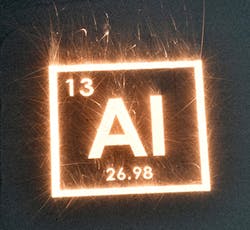(Image: HRL)
Additive manufacturing (also called 3D printing) of metal components, in which the component is built up layer by layer by fusing a metal powder precursor, is often accomplished using lasers, but can also be done with electron beams or other directed-energy sources. In any case, all you need to 3D print a component to your specs, other than the additive-manufacturing equipment itself, is a supply of powder of the right grit made out of the metal of your choice -- right?
Wrong.
As one knowledgeable in laser technology but not in additive manufacturing, this is what I thought -- that 3D printing could be used to make high-quality metal components out of almost any metal that you could make a powder of. But, as I discovered from a technical paper published by researchers at HRL Laboratories (Malibu, CA; formerly Hughes Research Laboratories) and the University of California, Santa Barbara, only a select few metals can conventionally be reliably 3D printed into high-strength components: these include a casting grade of aluminum (AlSi10Mg), a titanium alloy (TiAl6V4), cobalt-chromium (CoCr), and the nickel-chromium-based alloy Inconel 718.1
Composition-tailored nanoparticles
The HRL researchers would not be discussing this info in their technical paper if they didn’t have a solution, and indeed they do; in fact their solution enables laser-based (and other) additive manufacturing of the extremely important 7075 and 6061 series aluminum alloys, which each have somewhat different desirable properties and both of which are widely used throughout the aerospace, automotive, and other industries (see video below). The HRL approach is also applicable to a wide range of other useful metal alloys.
(Video: HRL)
Additive manufacturing of metals typically begins with alloy powders that are applied in thin layers and heated with a laser (or other direct heat source) to melt and solidify the layers. Normally, if high-strength unweldable aluminum alloys such as 7075 or 6061 are used, the resulting parts suffer severe hot cracking -- a condition that renders a metal part able to be pulled apart like a flaky biscuit.
HRL solves this problem by decorating high-strength unweldable alloy powders with specially selected nanoparticles. The nanoparticle-functionalized powder is fed into a 3D printer, which layers the powder and laser-fuses each layer to construct a 3D object. During melting and solidification, the nanoparticles act as nucleation sites for the desired alloy microstructure, preventing hot cracking and allowing for retention of full alloy strength in the manufactured part.
AI solves the problem
To find the correct nanoparticles, the HRL researchers enlisted Citrine Informatics (Redwood City, CA) to help them sort through the myriad possible particles using Citrine’s artificial-intelligence (AI) algorithms to find the one with the properties they needed.
The result for this case (aluminum 7075 and 6061) was zirconium-based nanoparticles; for other alloys, nanoparticles of different composition could be the result.
Metallurgy is not as straightforward as it used to be, but it’s nothing that a bit of AI can’t help with.
REFERENCE:
1. John H. Martin et al., Nature (2017); doi:10.1038/nature23894
Additional source: http://www.hrl.com/news/2017/0920/
About the Author
John Wallace
Senior Technical Editor (1998-2022)
John Wallace was with Laser Focus World for nearly 25 years, retiring in late June 2022. He obtained a bachelor's degree in mechanical engineering and physics at Rutgers University and a master's in optical engineering at the University of Rochester. Before becoming an editor, John worked as an engineer at RCA, Exxon, Eastman Kodak, and GCA Corporation.

